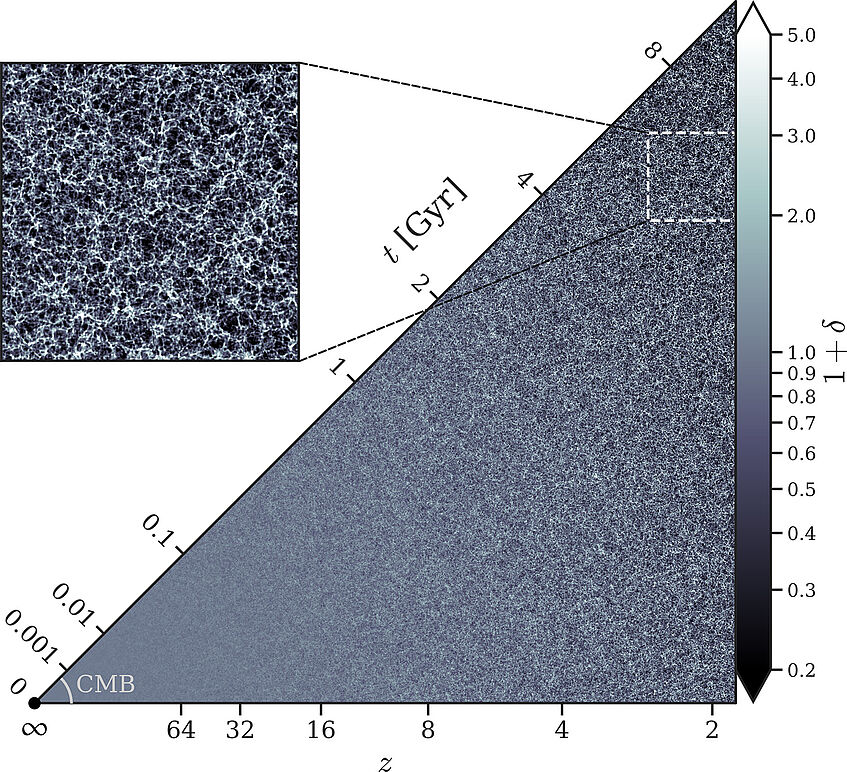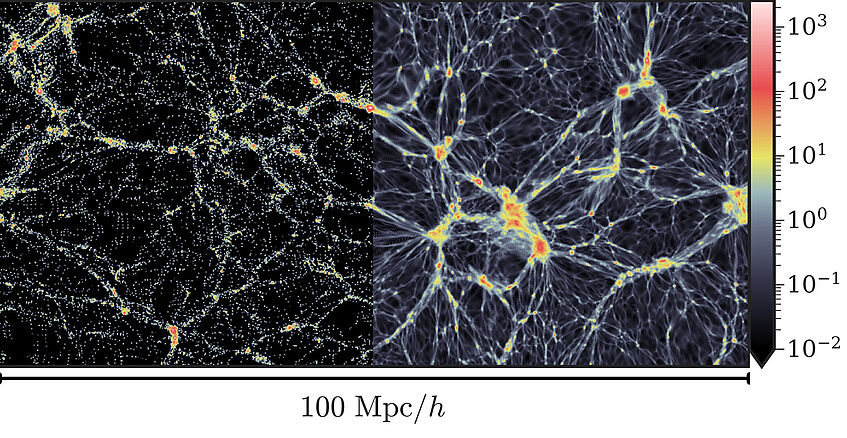Starting Cosmological Simulations from the Big Bang
Starting Cosmological Simulations from the Big Bang
23.04.2024
A team of astrophysicists from the University of Vienna found a way to integrate sophisticated mathematical modelling into simulations of the Universe, making it possible to initialize simulations directly with the Big Bang and follow the evolution of cosmic large-scale structures. The study was recently published in the journal “Physical Review Letters”.
On the largest observable scales in the Universe, matter is distributed in filamentary structures. In their mass and spatial distributions, these large filaments contain a wealth of information that can be used to understand how structures formed and evolved from the beginning of the Universe until today, i.e., how the stars and galaxies in our immediate surroundings developed in time.
To decode this information, cosmologists typically use a delicate combination of different methods. On the one hand, mathematical models are necessary to describe the early evolution of the Universe, during the first 100 million years after the Big Bang. On the other hand, numerical simulations are used to follow the buildup of cosmic structures over the subsequent 14 billion years until today.
"Traditionally, cosmological simulations use a velocity variable that does not allow going all the way back in time to the Big Bang, when the size of the Universe was infinitely small. Therefore, these simulations have to be initialised some millions of years after the Big Bang, using a mathematical theory relying on a more suitable notion of velocity. Switching to this velocity in the cosmological simulations makes the initialisation step obsolete, and one can simulate the formation of galaxies and other cosmic structures straight from the Big Bang to the present day.", explains Florian List, astrophysicist at the University of Vienna.
Slice through the matter density in the Universe on large scales (total width: ~500 million light years), from a standard cosmological simulation (left) and with the improvements introduced by List et al. (2024), that yield a more continuous distribution (right). This is crucial for starting simulations directly from the Big Bang.
Video Oliver Hahn: What happened after the Big Bang?
Beginning at time zero
In a recent work, a team of cosmologists from the University of Vienna, led by Florian List, have presented for the first time a novel simulation framework that makes it possible to model the evolution of cosmic structures in a unified setting, and beginning directly at time zero, the Big Bang.
These cosmological simulations are different from everything that has been done in the past, because the sophisticated mathematical models that are needed to describe the early stages of the evolution of the universe are automatically built in. "Cosmological simulations usually consume a lot of time and resources to compute the evolution of cosmic structures during the first hundred million years after the Big Bang, despite the fact that an excellent analytical description is available for how structures form in this epoch.”, says List. “By building this theoretical knowledge into cosmological simulations, we can fast-forward the simulations and directly skip from the Big Bang to a time some hundred million years after, without sacrificing accuracy."

The evolution of cosmic structures as seen by photons propagating from the Big Bang (bottom left corner), simulated within the unified framework (List et al., 2024). (c) Florian List
Unraveling cosmic puzzles
This novel approach allows them to unravel cosmic puzzles over the whole lifespan of the Universe and to extend our fundamental understanding of nature. "Cosmological simulations enable the comparison between the predictions arising from our most fundamental theories in physics to the high-quality astronomical observations that are currently being carried out by space missions such as Euclid.
Crucial to make these simulations as fast as possible
For instance, 95% of the energy content of the present-day Universe are thought to be in the form of dark matter and dark energy, and although a vast range of possible explanations exists, the very nature of these two mysterious components is still unknown.”, notes Oliver Hahn, co-author of the study and professor at the Department of Astrophysics as well as Mathematics. “Unfortunately, cosmological simulations are computationally expensive, so in order to test as many well-motivated theories as possible against observations with a limited amount of time and resources, it is crucial to make these simulations as fast as possible. Building analytical knowledge of cosmic structure formation into the simulations allows reducing the number of time steps between the Big Bang and today, resulting in faster simulations."

In this figure, one of the first released by Euclid, the galaxies of the Perseus cluster are visible in the centre; in the background, hundreds of thousands of more distant galaxies can be seen.
(Credit: ESA/Euclid/Euclid Consortium/NASA, image processing by J.-C. Cuillandre (CEA Paris-Saclay), G. Anselmi -- LICENCE: CC BY-SA 3.0 IGO / ESA Standard Licence
Original Publication
Starting Cosmological Simulations from the Big Bang. Florian List, Oliver Hahn, and Cornelius Rampf. Phys. Rev. Lett. 132, 131003 2024 DOI: https://doi.org/10.1103/PhysRevLett.132.131003

